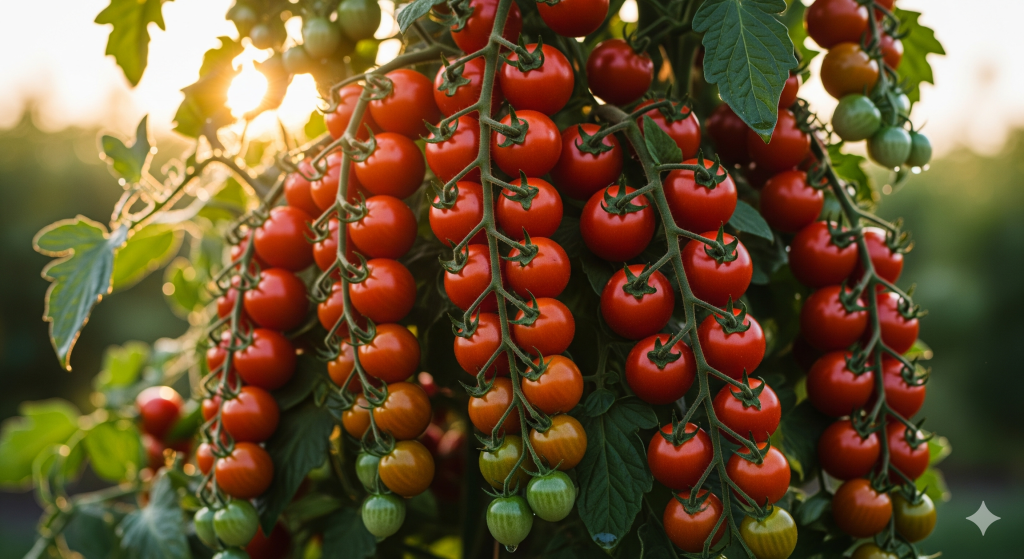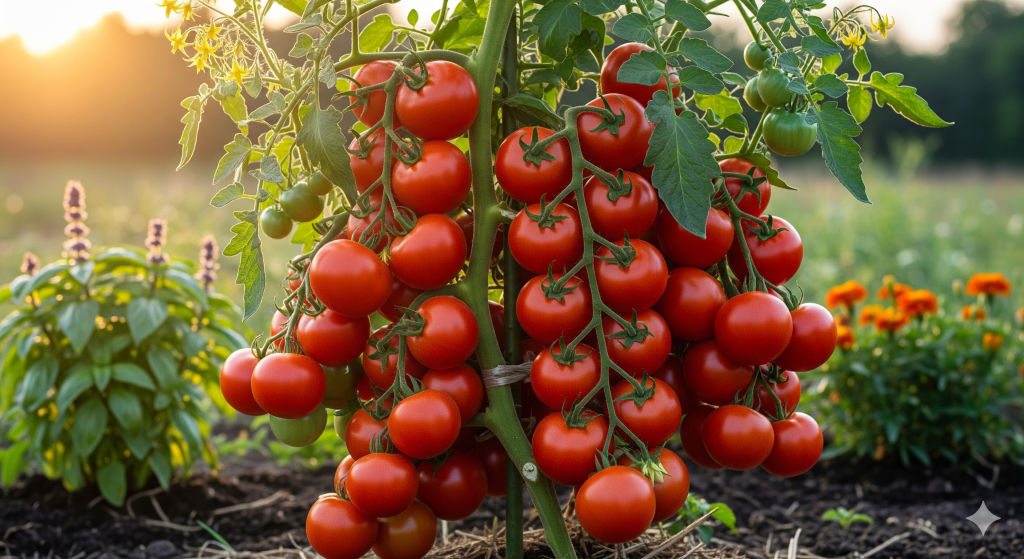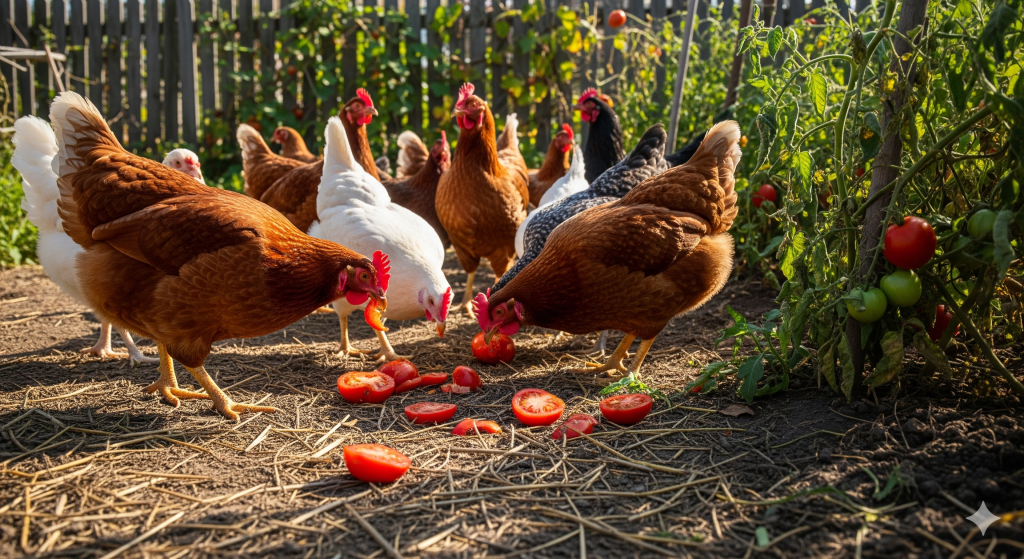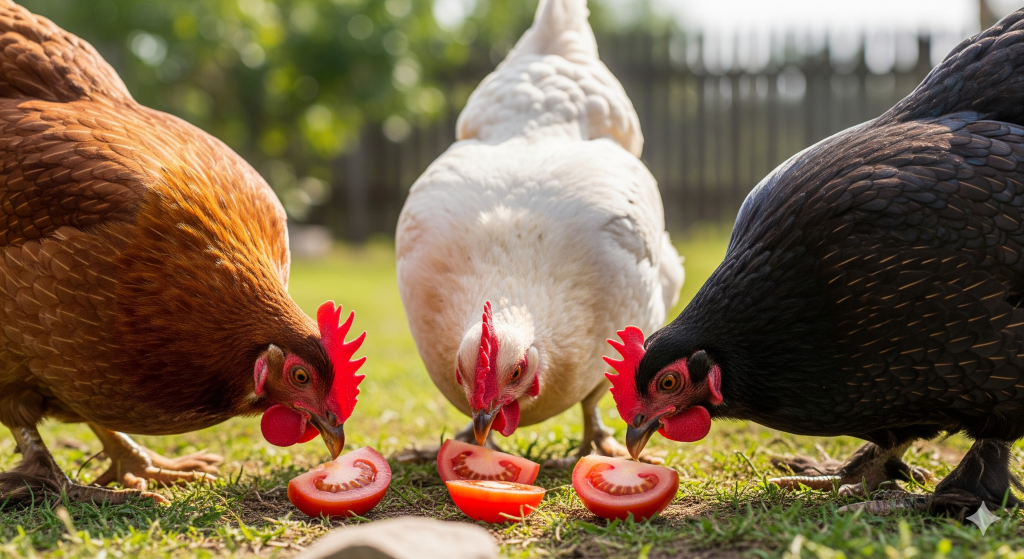Table of Contents
It’s one of the most exciting and fundamental questions a gardener can ask: “How many tomatoes can one plant produce?” Whether you’re meticulously planning your garden layout to maximize a harvest for canning, or you’re simply curious about the potential bounty from a single patio pot, understanding the yield of a tomato plant is key. The truth is, there is no single magic number. The final tally can range from a modest handful to a truly staggering, seemingly endless supply.
The final yield of a tomato plant is not a matter of luck; it’s a result of a fascinating interplay between genetics, environment, and care. The most significant factor is the plant’s growth habit—whether it is a determinate or indeterminate variety. This single genetic trait dictates not only the size of the plant but also the quantity and timing of its harvest.
This in-depth guide will demystify the concept of tomato yield, breaking down the differences between plant types and providing realistic expectations. We’ll explore averages per plant and per square foot, discuss harvesting frequency, and delve into the prolific world of cherry tomatoes, giving you the knowledge you need to both predict and maximize your homegrown harvest.
How Many Tomatoes Can I Get from a Single Plant?
To answer this question, you must first identify the type of tomato plant you are growing. Tomato plants are categorized into two primary growth habits, and their production patterns are vastly different.
Determinate Tomatoes: The Sprinters
Determinate tomato plants are often called “bush” tomatoes. They are genetically programmed to grow to a fixed, compact size, typically 3-4 feet tall. They produce their flowers and fruit in a concentrated burst over a relatively short period, usually 4-6 weeks. Once this main crop has ripened, the plant will produce very little new growth or fruit and its life cycle will be complete.
- Best For: Gardeners with limited space, container gardening, and those who want a large, single harvest for canning, saucing, or preserving.
- Typical Yield: A healthy determinate plant can produce 10-15 pounds (4.5-6.8 kg) or more of fruit. In terms of numbers, this could be anywhere from 25 to 50+ tomatoes, depending heavily on the variety (e.g., smaller Romas vs. larger slicers).
- Examples: ‘Roma’, ‘Rutgers’, ‘Celebrity’, ‘Bush Goliath’.
Indeterminate Tomatoes: The Marathon Runners
Indeterminate tomatoes are the vining type. They will continue to grow, flower, and produce fruit along their ever-lengthening stems throughout the entire growing season, stopping only when killed by the first hard frost. These plants can easily reach heights of 6-10 feet or more and require substantial staking or caging for support.
- Best For: Gardeners who want a steady supply of fresh tomatoes for salads and sandwiches all summer long, and those with space for tall supports.
- Typical Yield: Given their long production window, indeterminate plants are the higher yielders. A healthy, well-supported plant can produce 15-30 pounds (6.8-13.6 kg) or more of fruit over the season. The number of fruits can be enormous, especially for smaller varieties.
- Examples: ‘Big Boy’, ‘Early Girl’, ‘Brandywine’, ‘Sun Gold’, and most heirloom varieties.

What is the average yield of tomatoes per plant?
Considering both types, a broadly accepted average yield for a single tomato plant in a home garden is between 10 to 30 pounds of fruit. However, this average is heavily skewed by the factors mentioned above. A determinate plant in a small pot might yield 8-10 pounds, while a sprawling indeterminate heirloom in a well-tended garden bed with a long growing season could easily produce 40 pounds or more. The most realistic expectation comes from knowing which type you are growing.
How many tomatoes can one plant produce per square foot?
This metric is most relevant to gardeners using intensive planting methods like Square Foot Gardening. The yield per square foot is directly related to the yield of the single plant occupying that space.
- For determinate (bush) varieties, you can typically plant one plant per square foot. Therefore, the yield per square foot is the plant’s total yield, around 10-15 pounds.
- For indeterminate (vining) varieties, they require more space. They are usually allocated a 2×2 foot area (4 square feet) to allow for their larger size. In this case, the yield from that patch would be the plant’s total (e.g., 20 pounds), but the average yield per square foot would be 5 pounds (20 pounds / 4 sq ft).
It’s more useful to think in terms of “yield per plant” and give each plant the square footage it needs to thrive.
How Many Times Can Tomatoes Be Harvested?
This, again, comes down to the plant’s growth habit.
- Determinate: These plants are harvested heavily over a short window. You can expect to perform 2-3 major pickings over a few weeks to gather the bulk of the crop as it ripens in a concentrated wave.
- Indeterminate: These plants are harvested continuously. Once they start ripening, you will be able to pick ripe fruit from them multiple times a week, every week, until the end of the season. The number of individual harvests is essentially countless; you simply pick them as they become ready.
Ready to Take Your Self-Sufficiency to the Next Level?

If you love the self-sufficient lifestyle, this is the only guide you’ll ever need. Learn how to generate your own power, secure your water supply, and become truly independent. No fluff, just actionable plans.
➡️ Check out The Self-Sufficient Backyard and start your journey today!
How Many Tomatoes Per Plant Per Week?
This question is most applicable to the steady production of indeterminate tomato plants. A determinate plant doesn’t produce a weekly quota; it produces a large flush all at once.
For a healthy indeterminate plant, the weekly yield will vary. Early in the season, you might harvest just a few fruits per week. However, during the peak of summer (typically late July and August), a vigorous plant can easily produce a pound or more of fruit per week. For a medium-sized slicing tomato, this could be 3-5 fruits. For a larger beefsteak variety, it might be 1-2 fruits per week.
How Many Cherry Tomatoes Per Plant?
This is where the numbers become truly impressive. Cherry tomato plants are almost always indeterminate and are known for their incredible prolificacy. They produce long trusses (clusters) of small fruit, and they do so relentlessly throughout the entire season.
A single, healthy cherry tomato plant can produce hundreds, and in some cases, well over a thousand, individual fruits over a full growing season. It’s not uncommon for a well-cared-for plant to yield so much that the gardener runs out of ways to use them all.
Cherry Tomato Yield Per Plant in kg
While counting hundreds of tiny fruits can be difficult, measuring by weight gives a great sense of their productivity. A typical cherry tomato weighs between 10 to 20 grams (about 0.3 to 0.7 ounces).
Given the sheer number of fruits, a healthy and mature cherry tomato plant can easily produce a total yield of 5 to 10 kilograms (approximately 11 to 22 pounds) over the course of a long growing season. This massive output from a single plant makes them one of the most rewarding and highest-yielding crops for any home gardener.
Conclusion
The number of tomatoes one plant can produce is not a fixed number but a dynamic outcome based on your choices and care. The most critical decision is selecting a variety that fits your goals: a compact determinate plant for a single, large harvest, or a sprawling indeterminate vine for a steady supply of fresh fruit all season long. From there, your yield is in your hands. By providing your chosen plant with at least six hours of sunlight, rich and well-draining soil, consistent water, and proper support, you empower it to reach its full genetic potential. Whether you end up with 15 pounds of canning tomatoes or a thousand sweet cherry tomatoes, understanding these factors transforms the question from one of chance to one of successful and rewarding cultivation.



